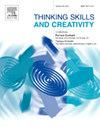Understanding scientific creativity criteria: Biologists’ assessments of PhD students’ creative products using the CAT
IF 3.7
2区 教育学
Q1 Social Sciences
引用次数: 0
Abstract
While creativity in science is praised, its meaning varies among scientists and it is unclear how they assess it in doctoral education. Research on evaluating scientific creativity among PhD students is rare. This study reports findings from assessing creative products developed by PhD biology students (n = 20) as the final project of a 10-week creativity course. The products were assessed by 24 biologist-judges with 18 years of average experience (SD = 9.92) clustered into three groups using the Consensual Assessment Technique (CAT). Biologists measured for creativity and additional dimensions – Scientific Impact, Originality, Thoughtfulness, Appropriateness, and Liking – commonly associated with scientific creativity. Agreement among biologists was substantial for Creativity in Groups 1 and 3, and some of the other dimensions. However, Group 2 showed lower agreements in general and poor agreement for Scientific Impact and Thoughtfulness. The biologist-judges’ knowledge and background, as well as the products’ characteristics, appeared to have impacted assessments. The products deemed the most creative and original did not necessarily score as the most scientifically impactful or most relevant. While the CAT is suitable to evaluate creativity in scientific products, additional considerations would be needed to measure domain-specific components more reliably in doctoral education. A broader set of criteria and more detailed information about the products to analyze could lead to more rounded assessments.
理解科学创意标准:生物学家对博士生创意产品的CAT评估
虽然科学上的创造力受到赞扬,但它的含义在科学家之间有所不同,也不清楚他们如何在博士教育中评估它。关于评价博士生科学创造力的研究很少。本研究报告了对生物学博士生(n = 20)开发的创意产品进行评估的结果,这些创意产品是为期10周的创意课程的期末项目。这些产品由24名平均具有18年经验(SD = 9.92)的生物学家评委进行评估,采用共识评估技术(CAT)将其分为三组。生物学家衡量的是创造力和其他维度——科学影响、原创性、周到性、适当性和喜欢度——这些通常与科学创造力有关。生物学家在第1组和第3组的创造力以及其他一些维度上达成了实质性的一致。然而,第二组在总体上的一致性较低,在科学影响和深思熟虑方面的一致性较差。生物学家法官的知识和背景,以及产品的特性,似乎影响了评估。被认为最具创造性和原创性的产品并不一定是最具科学影响力或最相关的。虽然CAT适用于评估科学产品中的创造力,但是在博士教育中需要额外的考虑来更可靠地衡量特定领域的成分。一组更广泛的标准和关于要分析的产品的更详细的信息可能导致更全面的评估。
本文章由计算机程序翻译,如有差异,请以英文原文为准。
求助全文
约1分钟内获得全文
求助全文
来源期刊

Thinking Skills and Creativity
EDUCATION & EDUCATIONAL RESEARCH-
CiteScore
6.40
自引率
16.20%
发文量
172
审稿时长
76 days
期刊介绍:
Thinking Skills and Creativity is a new journal providing a peer-reviewed forum for communication and debate for the community of researchers interested in teaching for thinking and creativity. Papers may represent a variety of theoretical perspectives and methodological approaches and may relate to any age level in a diversity of settings: formal and informal, education and work-based.
 求助内容:
求助内容: 应助结果提醒方式:
应助结果提醒方式:


